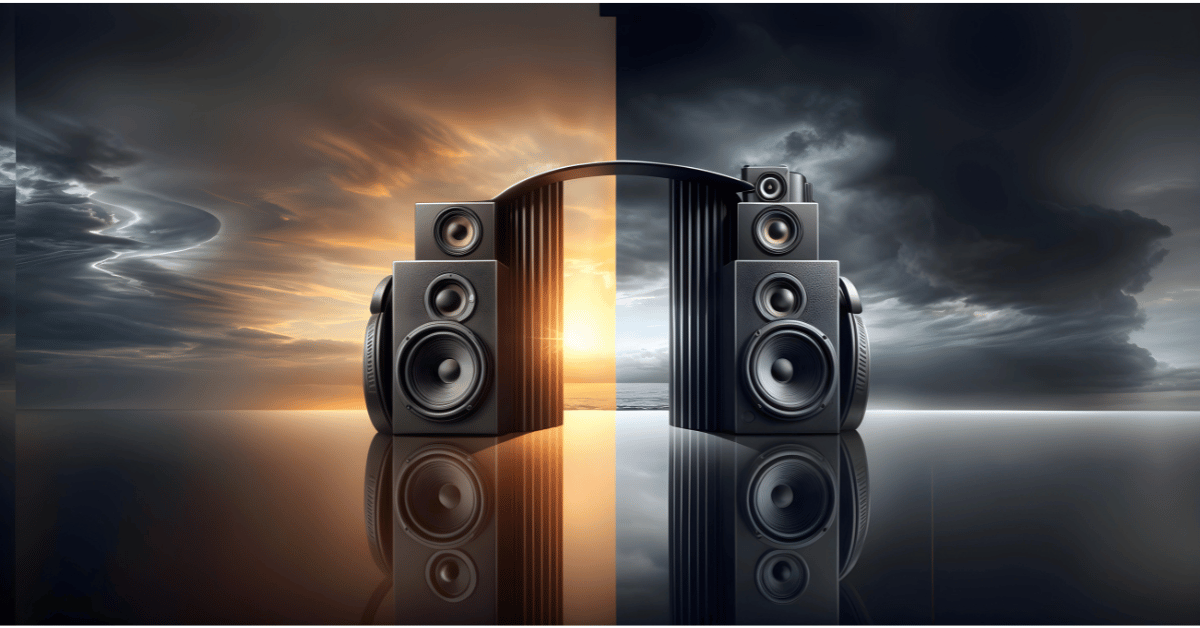When it comes to sound systems, the choice between full-range speakers and component speakers is crucial. Today, we’ll dive into the Full-Range vs. Component Speakers debate. As tech enthusiasts and audio lovers, we understand that the wide range of options can be overwhelming. But fear not! Our guide will demystify the technical jargon and highlight the key differences between these speaker types. So, you can make an informed decision that aligns perfectly with your acoustic goals.
What are Full-Range Speakers?
Full-range speakers are versatile speakers that can handle the entire range of sound using just one driver. This means they can reproduce every note, from the high-pitched chime of a triangle to the deep thrum of a bass guitar, without needing multiple drivers.
Full-range speakers, also known as single-driver speakers, are gaining popularity due to their simple design and authentic sound reproduction. These speakers are ideal for audio purists who seek a cohesive and lifelike sound. We will provide you with the necessary knowledge about the benefits and considerations of owning a full-range speaker.
Key Features of Full-Range Speakers
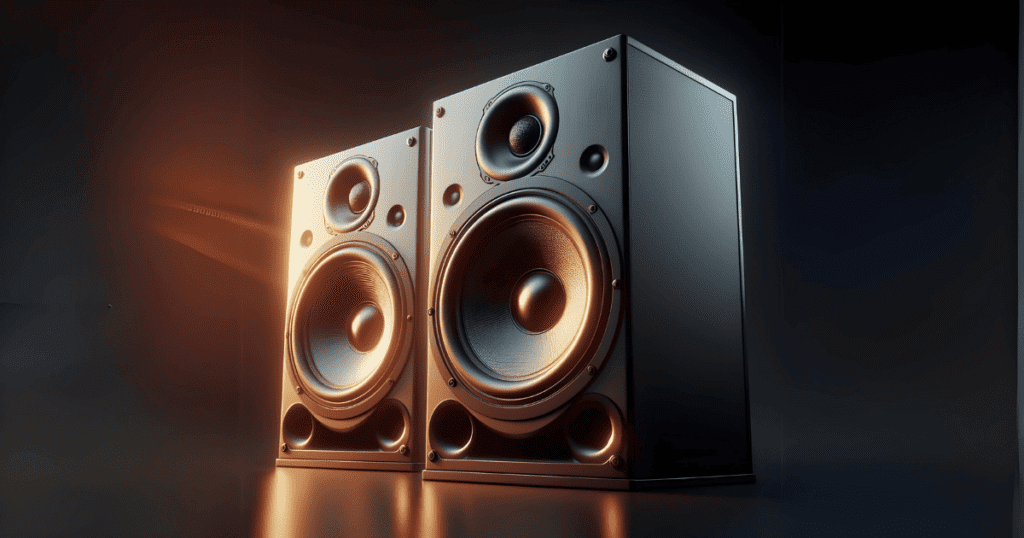
- Frequency Coverage: Full-range speakers, also known as wide-band speakers, can handle a wide range of sounds, typically from around 150 Hz to 20 kHz. This means they can reproduce everything from the low bass notes to the highest audible frequencies.
- Octave Ability: Full-range speakers are capable of reproducing at least 6 octaves, which makes them very versatile.
- Single Driver Systems: In some audio setups, like portable Bluetooth or smart speakers, full-range speakers may be the only audio output source, relying on a single driver to produce all frequencies.
- Design Ingenuity: Engineering full-range speakers to cover the entire sound spectrum involves creative design using compliant cones for low frequencies and lightweight materials for clear highs.
- Shape and Size Diversity: Full-range speakers come in various shapes such as circular, square, or oval, catering to different design preferences. They are available in sizes ranging from 2 inches to 8 inches in diameter.
- Power Range: These speakers are suitable for various applications and can handle power ranging from 1 watt to 100 watts.
- Coaxial Speakers – A Special Mention: Coaxial speakers, which consist of a tweeter inside a woofer, are also considered part of the full-range category. They offer a compact solution for car audio systems and ambient music without compromising on space.
Pros and Cons of Full-Range Speakers
Pros
- Sound Harmony: With no divides in the frequency, your tunes come out clean, providing a more organic audio experience.
- Simplicity: With one driver handling all frequencies, installation is straightforward and easy, making it ideal for DIY enthusiasts.
- Integrated Sound: Enjoy a seamless audio experience without the multi-driver induced distortions.
- Budget-Friendly: Favorable for budget-conscious audiolovers who don’t want to sacrifice sound quality.
Cons
- Customization Limits: Multi-way systems offer more tailored sound while full-range speakers provide a one-size-fits-all solution. Full-range speakers offer excellent quality within their range but lack fine-tuning options.
- Pushing the Limits: When played at higher volumes, full-range speakers may not perform as well, potentially leading to distortion as they try to cover all frequencies simultaneously.
- Bass and Treble Boundaries: While these speakers deliver solid mid-tone performance, they may struggle with ultra-high or deep low frequencies.
Ideal Use Cases for Full-Range Speakers
Full-range speakers are perfect for audio environments with limited space and a focus on exceptional sound quality. They are an excellent choice for:
- Home Theatre Systems: Enjoy consistent sound quality in a small space without the hassle of multiple speakers.
- Casual Listening: Perfect for music enthusiasts who love listening to their favorite tracks at home or in the office.
- Car Audio Systems: With coaxial speakers, get an immersive audio experience without complicated installation.
- Portable Speakers: Full-range speakers in portable and Bluetooth speakers deliver well-balanced sound in a compact package.
- All-in-one Systems: Designed for soundbars and other compact solutions where space is limited but a full soundstage is desired.
- Vintage Audio Equipment: Perfect for those who appreciate the nostalgic feel of vintage single driver speakers with minimalist design and straightforward functionality.
What are Component Speakers?
When it comes to achieving the best sound quality in your car, component speakers are the top choice. These speakers bring your music to life, delivering a dynamic and expansive sound that often surpasses standard speakers. If you want to enhance your audio experience on the road, consider the significant impact that component speakers can make.
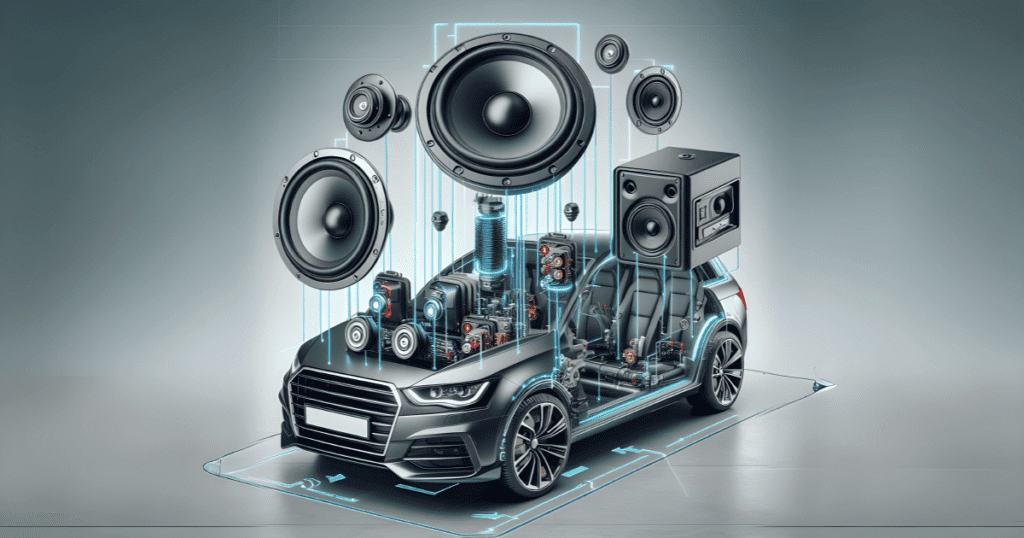
Component speakers come as a complete set, with specialized speakers that handle specific parts of the sound spectrum. It’s like assembling a team of experts, where each member excels in their area. By strategically placing these speakers throughout your car, they work together to fill the space with crisp, rich, and full audio, akin to a live concert.
Typically, music enthusiasts mount these speakers in custom enclosures, usually at the back of the car, along with an amplifier to maximize power. And for those who crave deep bass, adding a subwoofer will not only make your sound system heard but also felt. So, if you’re ready to transform your ride into a mobile auditorium, component speakers are your ticket to audio bliss.
Component Speakers Parts
Component speakers are the top choice for car audio enthusiasts who want to achieve a dynamic and high-quality sound experience in their vehicle. Curious about what component speakers are and what they include? Here’s a simple breakdown:
Tweeters
- Take care of high sound frequencies, producing crystal-clear high notes.
- Should be placed near ear level for the best directional sound.
- Need to be close enough to woofers to create a cohesive soundstage.
Subwoofers
- Handle the low bass frequencies, also known as the midrange or midbass.
- Typically installed in a car’s doors to provide resonant, deep bass.
- Lay the foundation for a rich sound by balancing out high frequencies.
Crossovers
- The “traffic cops” of the car audio system, directing frequencies to the correct speakers.
- Commonly installed near the doors or the dashboard.
- Ensure high frequencies go to the tweeters and low frequencies to the woofers.
Read on as we dive deeper into the synergy between these components and how they create the ultimate in-car audio experience.
Pros and Cons of Component Speakers
Pros
Clarity of Sound:
- Built-in crossovers enhance speaker performance.
- Deliver clear and detailed audio, separating individual instrument sounds.
- Experience the true dynamic qualities of your favorite songs.
Superior Soundstage:
- Notice a distinct difference from standard car speakers.
- Feel like the music is originating from in front of you, not just anywhere in the car.
Enhanced Imaging:
- Tweeter placement contributes to advanced sound clarity.
- Achieve precise audio imaging for an immersive listening experience.
Personal Pride:
- Owning component speakers can be a source of personal joy.
- Reflects a passion for quality sound and confidence in your car’s audio system.
Cons
While component speakers can elevate your in-car audio experience, there are some potential downsides to consider:
Higher Cost
Generally, component speakers are pricier than their coaxial counterparts.
- A comparison of similar-sized speakers (6.5” component vs. 6.5” coaxial) can reveal a cost difference.
- Decide if the investment for superior sound is worth it for you.
Challenging Installation Process
- Replacing factory speakers with coaxial ones is straightforward — it’s a simple swap.
- Installing component speakers can be complex if you’re adding new speaker locations or tweeters.
- You may need to find a suitable spot for the crossover and drill holes for tweeters.
- A professional installer might be necessary, adding to the expense.
Ideal Use Cases for Component Speakers
Component speakers are ideal when you prioritize sound quality and detail. Here are some scenarios where they excel:
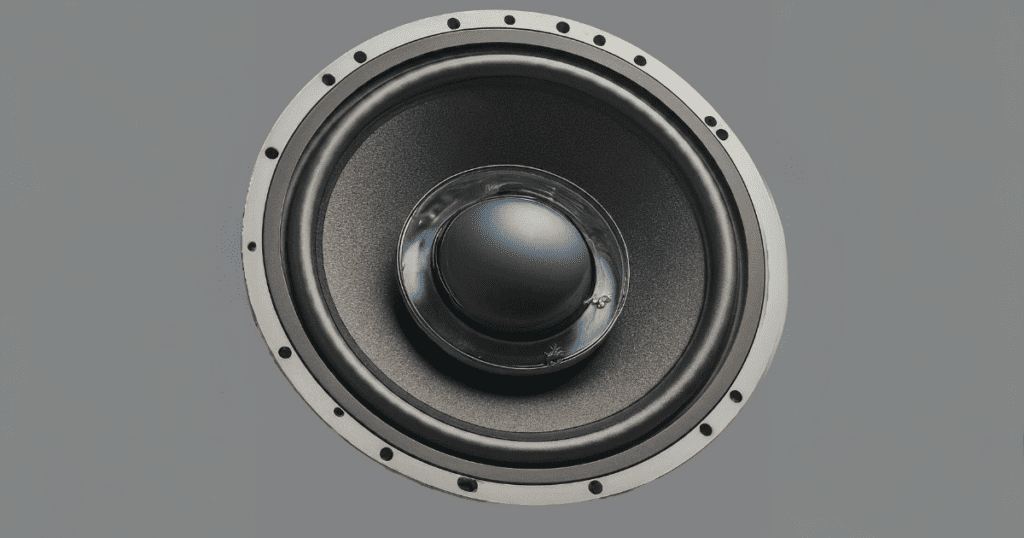
- Audiophile’s Car Audio: Perfect for those who want precise and pure sound while driving.
- Deluxe Home Audio Setups: They can be integrated into high-end home audio systems for clear sound staging.
- Competitive Sound Systems: Useful in environments where sound quality and authenticity are crucial.
- Professional Recording Studios: They are essential for accurate monitoring in audio mixing and mastering.
- Luxury Vehicle Upgrades: Ideal for luxury vehicle owners seeking the ultimate in-car audio experience.
- Concert Simulation Environments: Create an in-car listening experience similar to a live concert performance.
- Custom Audio Installations: They shine in custom installations, allowing control of component placement and tuning.
Comparison Table: Full-Range vs. Component Speakers
When deciding between full-range (also known as coaxial) speakers and component speakers for your sound system, it’s essential to understand the differences. Both have their unique advantages and applications. Here’s a table to help you compare full-range and component speakers comprehensively:
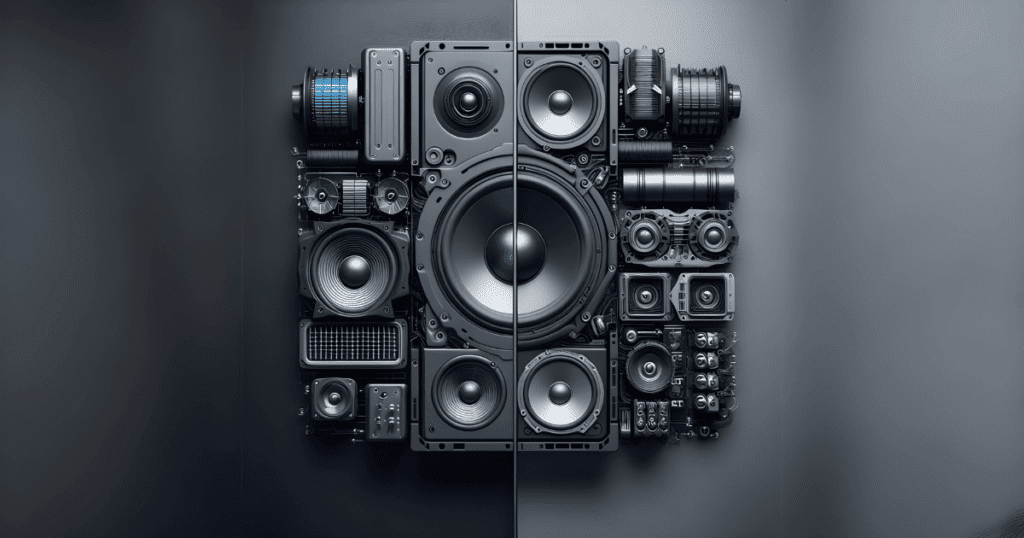
| Feature | Full-Range Speakers | Component Speakers |
| Design | Single unit with combined elements (tweeters, woofers) | Set of separate speakers for specific frequency ranges |
| Installation | Simple and direct replacement for factory speakers | More complex, requires specific component placement |
| Sound Quality | Good sound quality, may lack depth and clarity | Superior sound quality, clear frequency separation |
| Cost | More affordable, budget-friendly | Higher cost due to complexity and potential installation |
| Sound Stage | Sound from one point, less immersive | Realistic and 3D sound field, resembling live concert |
| Imaging | Less precise, all frequencies from the same location | Improved imaging with strategic tweeter and woofer placement |
| Customization | Limited customization due to built-in elements | Higher customization potential with individual components |
| Space & Aesthetics | Compact design, ideal for smaller spaces | Requires more space, may impact aesthetics and available space |
| Ideal Applications | Casual listeners, budget upgrades | Audiophiles, music enthusiasts, seeking the highest audio fidelity |
Conclusion
In conclusion, component speakers are the best choice for car audio, offering unmatched sound quality that enhances every drive. They deliver clear highs, deep bass, and create a soundstage that makes you feel like you’re at a live concert. While the initial investment and installation may be more involved than standard speakers, the audio payoff is invaluable for car enthusiasts and audiophiles. Advances in audio technology make component speakers a must-have for those serious about car sound systems. Whether it’s for personal pride, professional quality, or simply the love of music, upgrading to a component speaker system ensures that every note is heard as intended — pure, detailed, and full of life. Embrace the next level of in-car audio with component speakers and elevate your music experience.
Frequently Asked Questions (FAQs)
What are the key differences between component and coaxial car speakers?
- Component speakers consist of separate parts like tweeters and woofers for specialized sound distribution, while coaxial speakers are all-in-one systems where all drivers are connected on a single axis.
How do crossovers improve the sound quality of component speakers?
- Crossovers act as traffic directors for sound frequencies, ensuring that high frequencies go to the tweeters and low frequencies to the woofers, thus enhancing the overall clarity and quality of the music.
Why are component speakers considered superior to standard car speakers?
- Component speakers offer clearer and more detailed audio quality, with better soundstage and imaging, providing an immersive listening experience akin to a live concert.
Are component speakers worth the investment for a casual listener?
- While component speakers are generally more expensive, they offer a significant upgrade in sound quality that can enhance the listening experience even for casual listeners who appreciate high-quality audio.
What is involved in the installation process of component speakers?
- Installing component speakers often involves identifying optimal locations for each component, possibly drilling holes for new tweeters, and finding suitable placement for the crossovers, which may require professional assistance.
Can component speakers be used in home audio setups?
- Yes, component speakers are adaptable to high-end home audio systems where detailed sound staging and precise audio reproduction are desirable.
What makes component speakers ideal for professional recording studios?
- The accuracy and detail provided by component speakers make them essential for activities like audio mixing and mastering in professional recording studios.
How do I choose the right component speakers for my car?
- When choosing component speakers, consider factors like speaker size compatibility with your vehicle, the quality of sound you desire, and your budget for both the speakers and potential installation costs.
Can the installation of component speakers impact a car’s resale value?
- High-quality audio installations may increase the appeal of a vehicle to potential buyers, especially those who are audio enthusiasts, potentially impacting the resale value positively.
If I’m not an audiophile, will I still notice the difference with component speakers?
- Yes, even those who aren’t audiophiles will appreciate the noticeable improvement in sound depth, clarity, and quality that component speakers provide over standard car audio systems.
This Post You May Like:)
